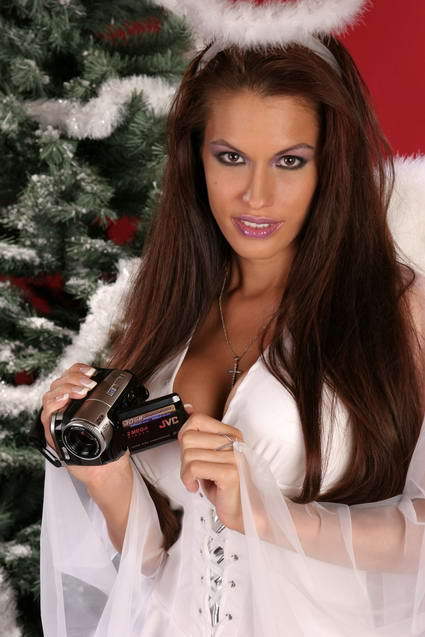Holiday Buyer's Guide 2005
And Now Videos: JVC Camcorder
As a family man with small kids, one of your reviewers has watched the evolution of digital camcorders with interest over the past few years. Nothing beats a light compact camcorder when it comes to capturing precious family moments for posterity - or blackmail, as the case may sometimes be! Either way, our biggest prior beef with camcorders has to with removable media: be they small 8mm style tape cassettes, mini CDs, DVDs, or whatever, there is always more work to do to play them back, put them on the computer, and whip them into presentable shape.
Of course, this new JVC Everio G Hard Disk Camcorder model GX-MG70u can't do away with that hassle entirely. But the Everio's internal 30 GB hard disk and very workable USB 2.0 interface makes it a lot less hassle to deal with recordings once they've been made; it also works with both Windows and Mac systems. The unit is incredibly compact and relatively light: at just over 15 oz (427 g) it's one of the lightest handheld camcorders we've ever used. Its dimensions are also petite: it's 2.64" (W) x 4.29" (L) x 2.76" (H), or 67 x 109 x 70 mm with the viewfinder closed, and the viewfinder itself only adds 2.75" (70 mm) to the width when fully extended. It's perfect for quick, spontaneous use, and fits well in the hand.
The Everio's biggest selling point is its hard drive, of course, so let's dispense with its capabilities first. The camera supports four different quality settings for video recording, each of which produces a different length for total shooting time. These settings vary not only in terms of resolution but also by bit rate, which explains the wide range of variation you see in the following table:
| Setting | Code | Resolution | Bit rate | Record time |
|---|---|---|---|---|
| Ultra Fine | U | 720x480 | 8.5 Mbps | 7 hrs |
| Fine | F | 720x480 | 5.5 Mbps | 10.5 hrs |
| Normal | N | 720x480 | 4.2 Mbps | 14 hrs |
| Eco | E | 352x240 | 1.5 Mbps | 37.5 hrs |
Image quality is of course a function of both bit rate and resolution. On modern TV sets the Ultra Fine setting produces the most viewable results, so that's the setting JVC uses by default. We can't really argue with this choice, observing that shooting even 7 hours of raw footage can be a lot of work, even for purely candid home movies.
There's a lot more to like about this compact little unit, however. The 1/6" 680,000 pixel CCD captures good looking (but relatively small format) images, both when shooting video or video stills; the latter can be captured to the internal hard disk, or to an SD memory card that goes in a slot in the camera. The lens supports both 25x optical zoom and 700x digital zoom for an incredibly wide range of image field. The unit's 2.5" color LCD is sharp and clear, though small; JVC has also done a good job of making its menus and navigation easy to see and follow in this unit.
Hooking up to a Windows machine is a snap: simply plug one end of a suitable cable into the mini-USB Type B port on the back of the camera, and the other into a standard Type A USB port. Windows should recognize the device immediately; if it does not, you may experience what we did when testing - namely "Unknown USB Device" showing up instead of a more typical USB device found status message. We advise that you use the cable that JVC includes with the camera to make the link-up: though our IOGEAR cable worked with all the other devices we tried on it, Windows didn't recognize the JVC camera until we used their cable.
Once you get the Everio connected, you'll see a collection of folders in its root directory. In a sub-folder inside the DCIM folder, you'll find still photos; a demo movie that extols the Everio's virtues is in the EXTMOV folder. The SD_VIDEO folder is where movies you record will appear; drag files that end with the .MOD extension onto the PowerDVD player included on the CD that ships with the unit, and all will be well.
Get Tom's Hardware's best news and in-depth reviews, straight to your inbox.
JVC also includes some useful software on its companion CD. In addition to the PowerDVD program you'll need to play back your movies, you'll also get copies of PowerDirector Express and PowerProducer as well. PowerDirector is a program that lets you edit digital video, and provides all kinds of tools and capabilities to manipulate digital video files. PowerProducer helps you turn those files into polished home movies by adding music or sound and special effects, and by stringing all the bits and pieces into a coherent sequence. JVC's documentation says that if you've already got versions of one or more of these programs installed, you must uninstall them before installing these. They also claim that only these versions will work with the camera's files, so this is advice worth heeding.
At an MSRP of $900 (most street prices averaged somewhat higher, in fact) this camcorder isn't cheap. We'd also urge you to buy an extra battery - and keep it charged and on hand - because the hard drive curtails battery life. After a two hour session of moving files back and forth from a PC that followed about half an hour of shooting, we had to plug the charger back in to keep the camera going. But despite this limitation, it's a snazzy little unit that will have even Santa looking forward to making and watching home movies.
Current page: And Now Videos: JVC Camcorder
Prev Page HP Photosmart R817 Digital Camera And Waterproof Case Next Page Time For Movies: The Optoma ProjectorEd Tittel is a long-time IT writer, researcher and consultant, and occasional contributor to Tom’s Hardware. A Windows Insider MVP since 2018, he likes to cover OS-related driver, troubleshooting, and security topics.

